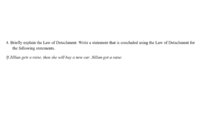rachelmaddie
Full Member
- Joined
- Aug 30, 2019
- Messages
- 851
In terms of providing geometric explanations and justification I’m not sure if I’ve answered this correctly for law of detachment.
The Law of Detachment states that if the hypothesis of a conditional statement is true, then the conclusion is also true.
If p —-> q is a true statement and p is true, then q is true which is read “if p, then q.”
Given: If Jillian gets a raise, then she will buy a new car. Jillian got a raise.
p = if Jillian gets a raise
q = then she will buy a new car
conclusion = Jillian got a raise.
Therefore, by the law of detachment, we can conclude that Jillian will also buy a new car.
The Law of Detachment states that if the hypothesis of a conditional statement is true, then the conclusion is also true.
If p —-> q is a true statement and p is true, then q is true which is read “if p, then q.”
Given: If Jillian gets a raise, then she will buy a new car. Jillian got a raise.
p = if Jillian gets a raise
q = then she will buy a new car
conclusion = Jillian got a raise.
Therefore, by the law of detachment, we can conclude that Jillian will also buy a new car.

